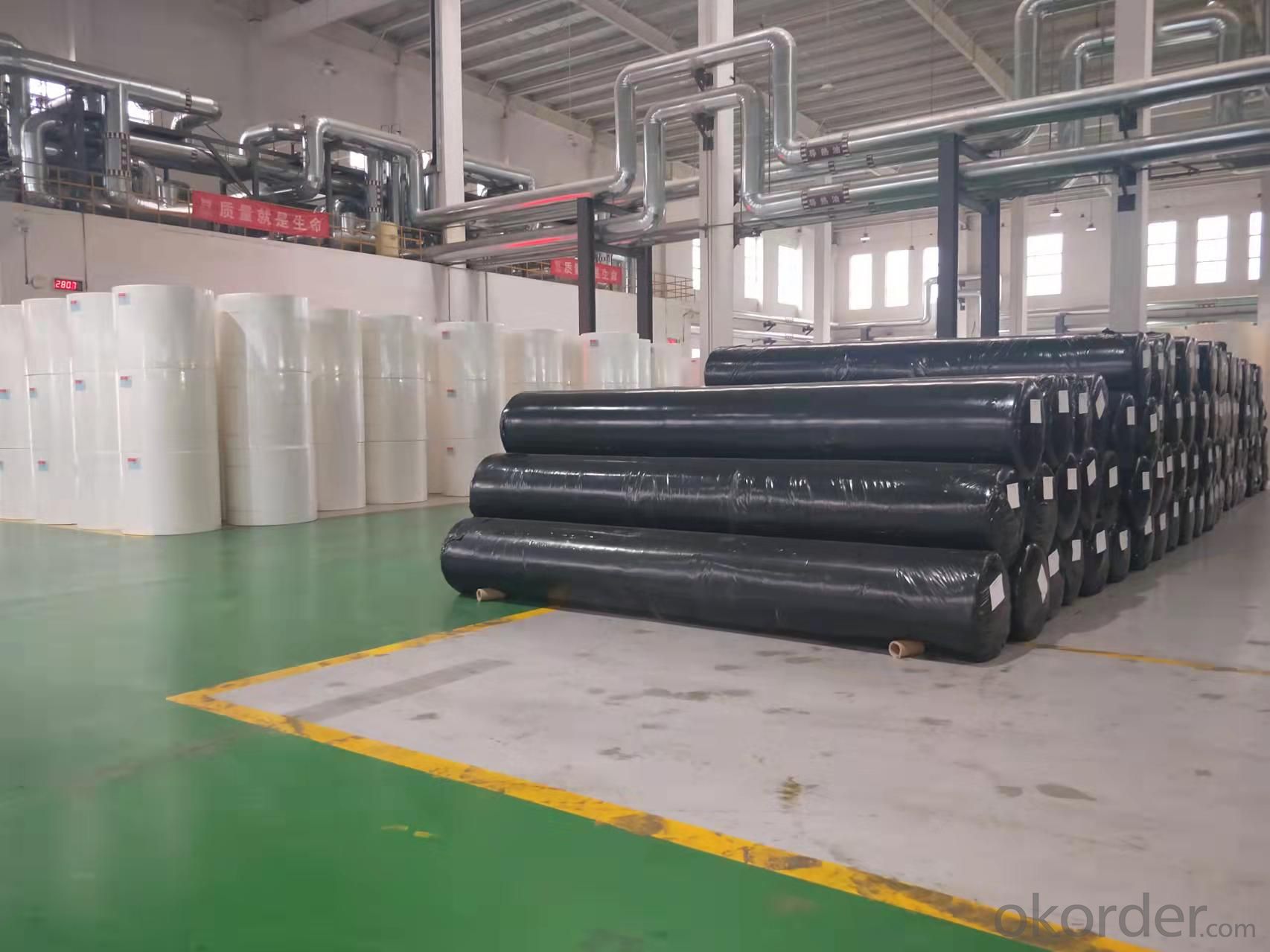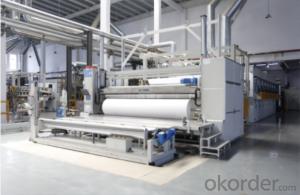polypropylene/polyester nonwovens geotextile, geosinthetic
- Loading Port:
- Shanghai
- Payment Terms:
- TT OR LC
- Min Order Qty:
- 5000 m²
- Supply Capability:
- 8000000 m²/month
- Option:
- 100-1000g/㎡
OKorder Service Pledge
Quality Product, Order Online Tracking, Timely Delivery
OKorder Financial Service
Credit Rating, Credit Services, Credit Purchasing
You Might Also Like
Product Description
POLYPROPYLENE FILAMENT NEEDLE PUNCHED GEOTEXTILE

Product Introduction:
Using high-strength polypropylene slice as the main raw material, it is produced by non-woven technology and has the functions of isolation, reinforcement, protection, filtration, drainage, and buffering.
Product specifications: TDF100~1000, width 1m~6m., length according to user requirements.
Features:
The physical and mechanical properties are 2 to 3 times higher than that of conventional products. The proportion of products with the same gram weight is low; the acid and alkali resistance is excellent, the hot melt adhesion is good, and the wear resistance is strong. It is more suitable for CRTS/ slab ballastless track sliding layer system, which can reduce the interaction between the track system and the bridge surface.
Applications:
Polypropylene needle-punched non-woven geotextile is mainly used for the sliding layer between CRTS slab ballastless track and beam surface of passenger dedicated railway, and the isolation layer between CRTS slab ballastless track and friction. It can also be widely used Hydropower, highways, railways, ports, airports, sports venues, tunnels, beaches, reclamation, environmental protection and other fields play the role of isolation, filtration, drainage, reinforcement, protection, etc.
| Iterms | Test Method | Unit | TDF6 | TDF13 | TDF22 | TDF28 | TDF35 | TDF42 | TDF50 | TDF56 | TDF65 |
| Physical Properties | - | - | Continuous filament spunbond needle punched 100% polypropylene, UV stabilized | ||||||||
| Polymer | - | - | |||||||||
| UV resistance-Tensile strength retention | ISO 10319(GB/T 15788) | After three months outdoor aging,Strength Retention>70% | |||||||||
| Chemical resistance | ISO 12960(GB/T 17632) | No effect in the range of PH2-13 | |||||||||
| Tensile Strength | ISO 10319(GB/T 15788) | kN/m | 6.0 | 13 | 22 | 28 | 35 | 42 | 50 | 56 | 65 |
| Elongation at Max Tensile Strength | ISO 10319(GB/T 15788) | % | 50-120 | ||||||||
| CBR Puncture Resistance | ISO 12236(GB/T 14800) | N | 1000 | 2100 | 3200 | 4200 | 5500 | 6500 | 7600 | 8700 | 10000 |
| Trapezoid Tear Strength | ISO 9073-4(GB/T 13763) | N | 200 | 500 | 700 | 900 | 1100 | 1200 | 1300 | 1400 | 1600 |
| Fall Cone Penetration Aperture(dia) | ISO 13433(GB/T 17630) | mm | 34 | 27 | 20 | 17 | 14 | 11 | 9 | 7 | 5 |
| Equivalent Aperture(dry sieving)(O90) | GBT 14799 | mm | 0.3 | 0.2 | 0.11 | 0.1 | 0.07 | 0.07 | 0.06 | 0.05 | 0.05 |
| Vertical Flow Rate(50mm Spout) | ISO 11058(GB/T 15789) | l/m2/s | 40 | 40 | 40 | 35 | 25 | 15 | 15 | 10 | 10 |
| vertical permeability coefficient | ISO 11058(GB/T 15789) | m/s | 2×10-1 | 2×10-1 | 2×10-1 | 2×10-1 | 2×10-1 | 1.5×10-1 | 9×10-2 | 6×10-2 | 3×10-2 |
| In-plane Water Flow 20kPa | ISO 12958(GB/T 17633) | l/m.h | 2×10-4 | 8×10-4 | 1×10-3 | 1×10-3 | 1×10-3 | 1×10-3 | 1×10-3 | 1×10-3 | 1×10-3 |
| Mass Unit Area | ISO 9864(GB/T 13762) | g/m2 | 100 | 200 | 300 | 400 | 500 | 600 | 700 | 800 | 1000 |
| Thickness 2kPa | ISO 9863-1(GB/T 13761.1) | mm | 0.8 | 1.6 | 2.2 | 2.8 | 3.3 | 3.8 | 4.1 | 4.5 | 5.0 |
| Grip Strength | ASTM D 4632(GB/T24218.18) | N | 400 | 1000 | 1500 | 2000 | 2500 | 3000 | 3500 | 4000 | 5000 |
| Elongation at Grip Strength | ASTM D 4632(GB/T24218.18) | % | 50-120 | ||||||||
| Punchture Resistance | ASTM D 4833(GB/T 19978) | N | 170 | 350 | 520 | 650 | 800 | 950 | 1050 | 1200 | 1400 |
| Permeability | ISO 11058(GB/T 15789) | s-1 | 1.0 | 1.0 | 1.0 | 0.5 | 0.4 | 0.25 | 0.2 | 0.1 | 0.05 |
| Product Specifications (Width) | GB/T 4666 | mm | 4000-5500 | ||||||||
| Fiber Fineness | GB/T 10685 | dtex | 4-15 | ||||||||
- Q:How do geotextiles contribute to soil improvement in soft ground areas?
- Geotextiles contribute to soil improvement in soft ground areas by providing reinforcement and stabilization. They act as a barrier between the unstable soil and the overlying structures, distributing the load and reducing settlement. Additionally, geotextiles allow for water drainage while preventing soil erosion, promoting healthy soil conditions for growth and stability.
- Q:Geotextile belongs to what industry
- Geotextile belongs to the building materials industry
- Q:How do geotextiles contribute to groundwater protection?
- Geotextiles contribute to groundwater protection by acting as a barrier that prevents the movement of contaminants from the surface to the groundwater. They are used in various applications such as erosion control, filtration, and separation, effectively reducing the risk of pollutants reaching the groundwater and preserving its quality.
- Q:Can geotextiles be used in road construction?
- Yes, geotextiles can be used in road construction. They are commonly used as a stabilization measure to reinforce the soil, control erosion, and enhance the overall performance of the road. Geotextiles help in distributing the load evenly, improving drainage, and preventing the intermixing of different soil layers. Additionally, they can also provide a barrier to prevent the intrusion of fine particles into the road base.
- Q:Composite waterproof board, is the waterproof board and geotextile stick together call it?
- Yes. Now there are mainly adhesive technology, thermal composite process, Laminating process.
- Q:Are geotextiles suitable for use in erosion control mats for revegetation?
- Yes, geotextiles are suitable for use in erosion control mats for revegetation. Geotextiles are designed to stabilize soil and prevent erosion by providing a barrier against water and wind. They also promote vegetation growth by allowing water and nutrients to penetrate the soil while protecting the roots from erosion. Overall, geotextiles can be an effective solution for erosion control in revegetation projects.
- Q:what do you mean nonwoven geotextiles ???
- please refer the folowing url to know all the details about non woven geo textiles
- Q:What are the key factors affecting the clogging behavior of geotextiles?
- The key factors affecting the clogging behavior of geotextiles include the particle size and gradation of the soil or other material being filtered, the permeability and porosity of the geotextile, the hydraulic loading conditions, the presence of fines or clay particles in the soil, and the duration of exposure to clogging agents. Other factors such as the geotextile's physical and chemical properties, the presence of biological organisms, and the maintenance practices also play a role in determining the clogging behavior.
- Q:Are geotextiles resistant to extreme temperatures?
- Yes, geotextiles are generally resistant to extreme temperatures. They are designed to withstand a wide range of environmental conditions, including high and low temperatures, without significant degradation or loss of performance.
- Q:Cement concrete bridge is a film curing or geotextile maintenance
- Commodity concrete pouring is completed, should be in the slurry after grinding as soon as possible to cover and sprinkler conservation. Commodity concrete bridge deck with full coverage of sprinkler conservation methods, covering materials with two sticky one geotextile, every 1t sprinkler once, to ensure the quality of conservation, to prevent cracks.
1. Manufacturer Overview |
|
|---|---|
| Location | |
| Year Established | |
| Annual Output Value | |
| Main Markets | |
| Company Certifications | |
2. Manufacturer Certificates |
|
|---|---|
| a) Certification Name | |
| Range | |
| Reference | |
| Validity Period | |
3. Manufacturer Capability |
|
|---|---|
| a)Trade Capacity | |
| Nearest Port | |
| Export Percentage | |
| No.of Employees in Trade Department | |
| Language Spoken: | |
| b)Factory Information | |
| Factory Size: | |
| No. of Production Lines | |
| Contract Manufacturing | |
| Product Price Range | |
Send your message to us
polypropylene/polyester nonwovens geotextile, geosinthetic
- Loading Port:
- Shanghai
- Payment Terms:
- TT OR LC
- Min Order Qty:
- 5000 m²
- Supply Capability:
- 8000000 m²/month
- Option:
- 100-1000g/㎡
OKorder Service Pledge
Quality Product, Order Online Tracking, Timely Delivery
OKorder Financial Service
Credit Rating, Credit Services, Credit Purchasing
Similar products
New products
Hot products
Related keywords































